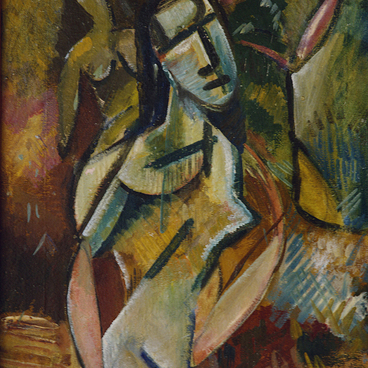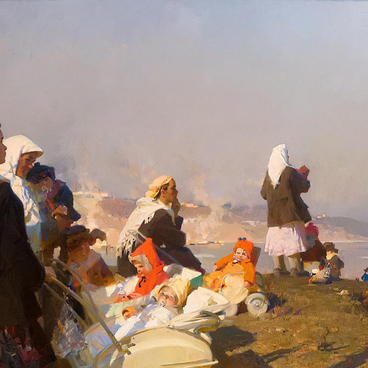Mikhail Le Dentu was a famous cubist and primitivist artist, theorist of avant-garde art. He actively promoted the latest trends in contemporary painting, delivered lectures and participated in disputes. Le Dentu was one of the authors of conceptual idea of allness. He believed that laws of painting could be mastered by studying the art of the past epochs.
In 1914, Le Dentu led the group of Russian futurists Bloodless Murder, which created works in an anarchist and carnival style that radically contradicted traditional art and anticipated absurdist style in many ways.
During his life, Le Dentu created 80 paintings. This is evidenced by the posthumous inventory of his paintings, compiled by his friends. Most of Le Dentu’s paintings were lost, and only 15 of his works survived to this day.
Many art historians note the similarity of Le Dentu’s primitive style with the late works by Picasso. Le Dentu designed sets for theater and cabaret, so his paintings are monumental and decorative in style.
The painting A Walk in the Park presented at the exhibition was created in the mature radiant cubist period in Le Dentu’s work. His paintings of this period are characterized by their restraint and seriousness that were not typical for provocative and shocking early Russian avant-garde.
The painting’s composition is built on vertical and horizontal axes architectonics, with the center of balance at the intersection of the axes.
Le Dentu based his color palette on tonal similarities, instead of color contrasts. The painting’s two-color scheme relies on combining gray-blue and ocher-brown colors. The artist created new shades of both colors, using white paint.
White color is also the main formative element in the painting, as it outlines the boundaries between colorful planes. According to Le Dentu’s design, white color plays an exceptional role, regulating the strength of other colors, in combination with original technique of using absorbent ground-color for softening oil paints to give them subdued colors of fresco painting.
In 1914, Le Dentu led the group of Russian futurists Bloodless Murder, which created works in an anarchist and carnival style that radically contradicted traditional art and anticipated absurdist style in many ways.
During his life, Le Dentu created 80 paintings. This is evidenced by the posthumous inventory of his paintings, compiled by his friends. Most of Le Dentu’s paintings were lost, and only 15 of his works survived to this day.
Many art historians note the similarity of Le Dentu’s primitive style with the late works by Picasso. Le Dentu designed sets for theater and cabaret, so his paintings are monumental and decorative in style.
The painting A Walk in the Park presented at the exhibition was created in the mature radiant cubist period in Le Dentu’s work. His paintings of this period are characterized by their restraint and seriousness that were not typical for provocative and shocking early Russian avant-garde.
The painting’s composition is built on vertical and horizontal axes architectonics, with the center of balance at the intersection of the axes.
Le Dentu based his color palette on tonal similarities, instead of color contrasts. The painting’s two-color scheme relies on combining gray-blue and ocher-brown colors. The artist created new shades of both colors, using white paint.
White color is also the main formative element in the painting, as it outlines the boundaries between colorful planes. According to Le Dentu’s design, white color plays an exceptional role, regulating the strength of other colors, in combination with original technique of using absorbent ground-color for softening oil paints to give them subdued colors of fresco painting.




